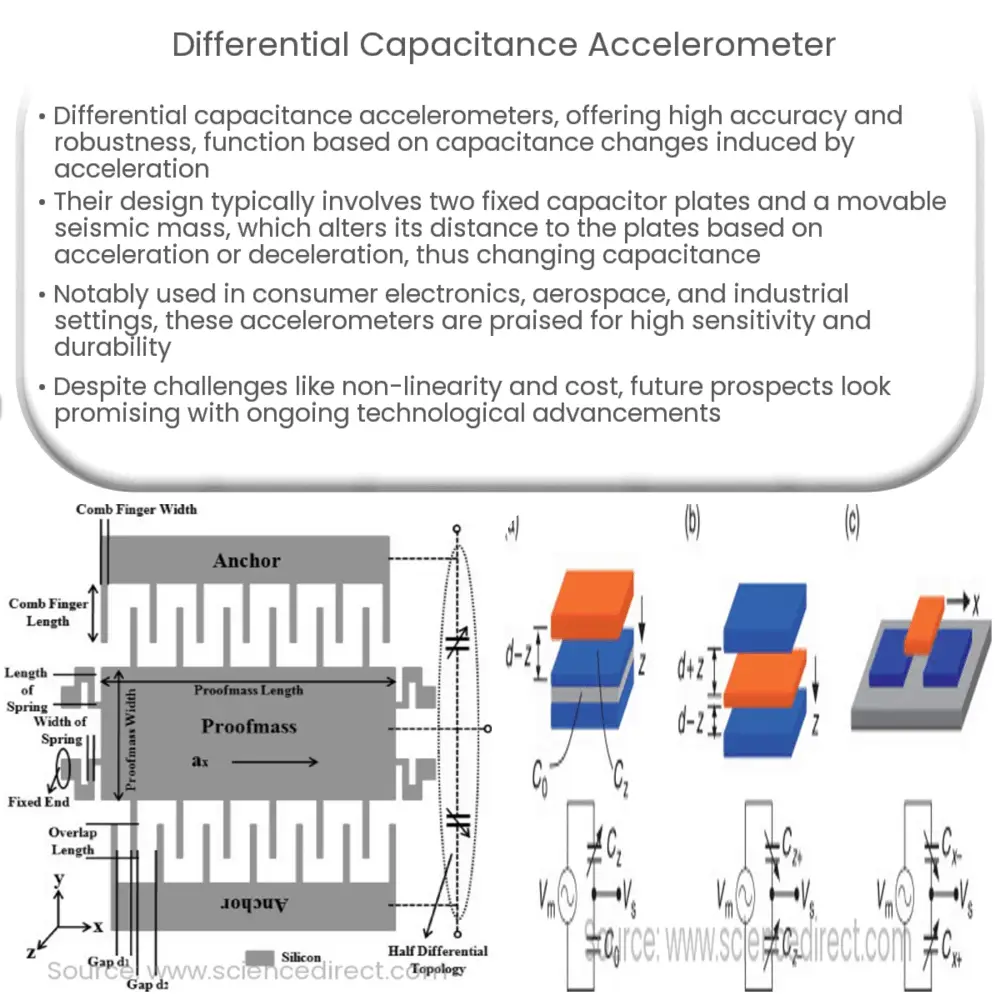Explore the workings, advantages, and applications of differential capacitance accelerometers, shaping technology’s future.

Differential Capacitance Accelerometer: An Insight
Accelerometers are essential components in numerous technological applications today, ranging from mobile devices to spacecraft. Among the diverse types of accelerometers, the differential capacitance accelerometer has garnered significant attention due to its superior accuracy and performance characteristics. This type of accelerometer operates based on changes in capacitance, offering high resolution and robustness.
Principle of Operation
The working principle of a differential capacitance accelerometer is hinged on the basic physics of capacitance. Capacitance, in essence, refers to the ability of a system to store electrical charge. When the spacing between the capacitor plates changes, so does the capacitance. This principle is applied in the design and operation of differential capacitance accelerometers, where movement or acceleration alters the gap between the capacitor plates, thus changing the capacitance.
Structure and Design
Typically, a differential capacitance accelerometer includes two fixed capacitor plates and a movable seismic mass in the middle. This seismic mass is commonly attached to a spring mechanism, allowing it to move relative to the external acceleration. When there’s no acceleration, the seismic mass stays in its equilibrium position, maintaining an equal distance from both capacitor plates.
- Acceleration Phase: When acceleration is applied, the seismic mass shifts due to inertia, altering the distance to the capacitor plates. This change in distance results in a change in capacitance, as per the inverse relationship between the two. The resulting differential capacitance is then measured and converted to an acceleration value.
- Deceleration Phase: Conversely, when the applied acceleration decreases, the seismic mass moves towards its equilibrium position, resulting in a change in capacitance. This change is again translated into a deceleration value.
By this, a differential capacitance accelerometer can measure both positive and negative acceleration effectively. Moreover, these accelerometers are known for their high sensitivity, allowing for accurate measurements even in scenarios involving very low accelerations.
Key Advantages
Differential capacitance accelerometers offer numerous benefits over other types of accelerometers. Their high sensitivity allows for precise measurements across a wide dynamic range. Also, these devices are robust, less prone to mechanical failure, and are able to operate in extreme environmental conditions.
Applications
Thanks to their versatility and high performance, differential capacitance accelerometers find extensive applications in diverse fields, including:
- Consumer Electronics: They are widely used in mobile devices for functions like screen rotation, gaming controls, and step counting.
- Aerospace: In aircraft and spacecraft, these accelerometers provide crucial data related to speed, altitude, and navigation.
Industrial Uses
Differential capacitance accelerometers are also utilized extensively in industrial settings. For instance, they play a crucial role in:
- Vibration Monitoring: They are deployed in various machinery and systems to monitor vibration levels, an essential factor in preventative maintenance.
- Structural Health Monitoring: In civil engineering, these accelerometers can be used to assess the health and safety of structures like bridges and buildings, providing valuable data that can help preempt structural failures.
Research and Development
In the field of research and development, differential capacitance accelerometers have proven valuable. They are used in studies related to human movement, animal locomotion, and even in seismic research, where they help scientists understand and predict earthquake activity.
Challenges and Future Prospects
Despite the numerous advantages, certain challenges persist in the usage of differential capacitance accelerometers. Factors such as non-linearity, temperature dependence, and noise can influence the performance of these devices. Moreover, their cost is relatively high compared to other types of accelerometers, which may hinder their widespread adoption in cost-sensitive applications.
However, ongoing research and advancements in technology are expected to overcome these limitations. With developments such as miniaturization and low-power electronics, the future of differential capacitance accelerometers seems promising, with potential for broader application and increased efficiency.
Conclusion
In conclusion, differential capacitance accelerometers are indispensable tools in today’s technology-driven world. Leveraging the principle of capacitance, they provide accurate and sensitive acceleration measurements across diverse applications. While challenges do exist, continual innovation and advancements hold the promise of expanding their potential uses and improving their overall performance. As such, differential capacitance accelerometers will undoubtedly continue to play a pivotal role in various sectors, from consumer electronics to industrial machinery and aerospace applications, helping to shape the future of technology.

